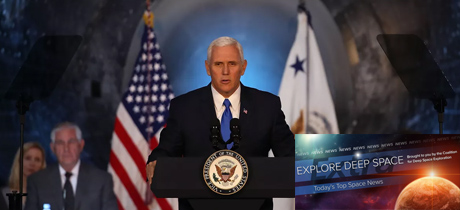In Today’s Deep Space Extra… NASA briefs Vice President Mike Pence, chair of the White House National Space Council. China’s recently launched mission to the Moon’s far side reaches lunar orbit. Roscosmos, the Russian space agency, seeks government support for a new rocket capable of lunar missions.
Human Space Exploration
Pence to NASA employees: Get used to the fast pace
Spacepolicyonline.com (12/12): During a visit to NASA in Washington on Wednesday, Vice President Mike Pence promised essential funding to complete the development of the Space Launch System (SLS) and Orion crew exploration capsule. At the same time, Pence, who also chairs the White House National Space Council, urged the workforce to get used to an urgency in their activities, activities on which Pence was briefed.
Houston Chronicle (12/11): NASA astronaut Nick Hague has put aside any concerns that his October 11 International Space Station (ISS) bound Russian Soyuz launch abort with cosmonaut Alexey Ovchinin might have dampened his enthusiasm for space exploration. The Russian spacecraft carrying the two men descended safely back to Earth two minutes after launching from the Baikonur Cosmodrome in Kazakhstan. Following a Soyuz return to flight on December 3 that delivered U.S., Canadian and Russian astronauts to the Space Station, the Russian space agency and NASA announced that Hague and Ovchinin would launch to the Space Station on February 28, joined by NASA astronaut Christina Koch. During a NASA news conference on Wednesday, Hague said he’s excited to launch.
Cosmonauts to transmit images of spacecraft’s hole from orbital outpost to Earth
TASS of Russia (12/12): During a lengthy spacewalk outside the International Space Station (ISS) on Tuesday, cosmonauts Oleg Kononenko and Sergey Prokopyev inspected the damaged exterior of the Soyuz crew transport spacecraft that was the source of a small but mysterious Space Station internal pressure loss in late August. The imagery gathered by the spacewalkers is being transmitted back to Earth for Russian investigators to assess as they strive to explain the cause and source of the damage. Some samples of material gathered from the hull of the capsule and pieces of the micro meteorite shielding next to the hull will return to Earth for analysis aboard the same Soyuz MS-09 spacecraft’s descent module as it returns to Earth on December 19-20 with three U.S., European and Russian astronauts and cosmonauts. The damaged and unoccupied orbital module is to separate from the MS-09 and burn up in the Earth’s atmosphere.
Space Science
NASA’s Juno mission halfway to Jupiter science
NASA/JPL (12/12): With all the recent excitement over the landing of the Mars InSight mission at Mars and the start of Osiris Rex proximity operations at the asteroid Bennu, it could be easy to overlook the scrutiny giant Jupiter is receiving from NASA’s Juno mission. On December 21, Juno will carry out its 16th close flyby of Jupiter, officially reaching the halfway point in its long orbital mission to better understand the solar system’s largest planet.
NASA to form task force to review planetary protection guidelines
Spacepolicyonline.com (12.12): NASA intends to update its planetary protection strategy based on outside recommendations, including those from the National Academy of Sciences (NAS). The effort is in response to emerging private sector interest in deep space destinations, including Mars, asteroids and other planetary bodies. Planetary protection has two elements, protecting the Earth from harm and not contaminating distant planetary environments that may host or may have once hosted some form of biological activity.
Finding alien life may require giant telescopes built in orbit
Scientific American (12/12): iSAT, a visionary concept from a group of scientists, engineers and technocrats, calls for the assembly of large space telescopes by astronauts as well as on going upgrades and repairs to advance the search for life beyond the Earth. Currently, the size and power of space telescopes are constrained by the performance of the rockets that launch them.
Other News
Chang’e-4 spacecraft enters lunar orbit ahead of first-ever far side landing
SpaceNews.com (12/12): China’s Chang’e-4 far side lunar lander and rover, launched on December 7, maneuvered on Wednesday into an elliptical orbit around the Moon. The mission’s lander and rover are to attempt the first landing on the Moon’s far side, perhaps in early January.
The Moon’s far side and China’s space strategy
The Diplomat (12/12): China’s Chang’e-4 lunar exploration ambitions are a sign that Beijing’s leadership is serious about establishing an independent lunar presence. One objective is to characterize the Chinese lander and rover’s destination, the immense lunar South Pole Aitkin Basin, including the presence of water ice, a resource for the distant production of rocket propellants as well as human life support needs.
Roscosmos to submit super-heavy rocket project to government
Sputnik News (12/13): By early next year, Roscosmos, Russia’s space agency, will seek government support a super heavy rocket that can reach lunar orbit for uncrewed missions. A second, more expensive version of the launch vehicle would support crewed missions to the lunar environs. The proposal is part of a multi-year development effort. The inaugural launch of such a super heavy rocket could be 2028, according to the report.

